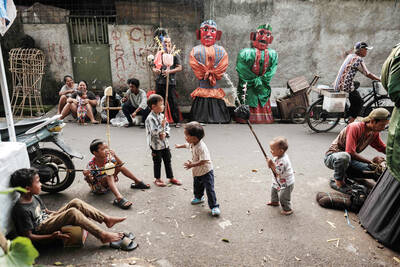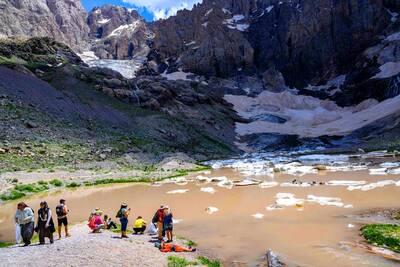China has approved a “modern redesign” of the Tibetan capital, state media said yesterday, including a limit on its downtown population.
Overseas rights groups have long complained that the Chinese government has failed to protect Lhasa and accuse Beijing of trying to flood the region with Han Chinese to dilute its ethnic makeup and assert greater control.
China rejects these charges, saying it has invested billions to improve lives in a region once blighted by serfdom and poverty and is committed to protecting its unique way of life and customs. By 2020, Lhasa will become an “economically prosperous, socially harmonious and eco-friendly modern city with vivid cultural characteristics and deep ethnic traditions,” a document carried on the central government’s Web site said.
The China Daily said the plan would make Lhasa “a coordinated and distinctive modern metropolis by 2020.”
Lhasa’s downtown population would be capped at 450,000 — the city only has 500,000 residents in total today — and just 75km² of land would be allowed to be used for urban development.
Lhasa is divided between an older, more traditional, Tibetan section, and a newer section where Han Chinese migrants dominate, complete with shopping malls and night clubs.
The urban makeover plan said local authorities should “pay great attention to protecting the historical, cultural and aesthetic characteristics” of Lhasa. That includes controlling the number, height and even color of buildings.
“Pay attention to the legal preservation of sites of necessary religious activities [and] satisfy the needs of the religious lives of believers,” the document said.
The China Daily said that when Beijing conducted its first census in Tibet in 1953, “Lhasa’s residents totaled only 30,000 and 4,000 of them were beggars.”
In related news, assailants threw a bomb into a newly built police station in a Tibetan area, a police official said yesterday amid heightened tensions and security during a volatile anniversary period. No injuries were reported.
The explosion just after midnight on Monday shattered windows at the station in Bogexi, a town in the predominantly Tibetan Ganzi prefecture, said Liu Xiaojun, a police official.
The building was not yet occupied and an investigation was under way, said Liu, who works at the public security bureau in Batang county, which oversees the town. Batang, in Sichuan Province’s far west, is about 7km from the Tibetan border.
The China Daily blamed “terrorists” for the blast, but provided no other details.
The incident came just days after the one-year anniversary of March 14 anti-Chinese riots in Lhasa. The violence last year spread to three other provinces in western China — Sichuan, Gansu and Qinghai — and was the most sustained and widespread Tibetan uprising in decades.
This month also marks the 50th anniversary of a failed March 10 revolt against Chinese rule in the Himalayan region that sent the revered Tibetan leader, the Dalai Lama, into exile.
Ganzi is known for its strong Tibetan identity and has been at the center of dissent for years. It saw some of the most violent protests last spring.
Last week, officials said they received an emergency notice from Sichuan’s provincial government to seal off the town of Kangding to foreigners, the last corner of Ganzi to remain open.

In the sweltering streets of Jakarta, buskers carry towering, hollow puppets and pass around a bucket for donations. Now, they fear becoming outlaws. City authorities said they would crack down on use of the sacred ondel-ondel puppets, which can stand as tall as a truck, and they are drafting legislation to remove what they view as a street nuisance. Performances featuring the puppets — originally used by Jakarta’s Betawi people to ward off evil spirits — would be allowed only at set events. The ban could leave many ondel-ondel buskers in Jakarta jobless. “I am confused and anxious. I fear getting raided or even

Kemal Ozdemir looked up at the bare peaks of Mount Cilo in Turkey’s Kurdish majority southeast. “There were glaciers 10 years ago,” he recalled under a cloudless sky. A mountain guide for 15 years, Ozdemir then turned toward the torrent carrying dozens of blocks of ice below a slope covered with grass and rocks — a sign of glacier loss being exacerbated by global warming. “You can see that there are quite a few pieces of glacier in the water right now ... the reason why the waterfalls flow lushly actually shows us how fast the ice is melting,” he said.

Eleven people, including a former minister, were arrested in Serbia on Friday over a train station disaster in which 16 people died. The concrete canopy of the newly renovated station in the northern city of Novi Sad collapsed on Nov. 1, 2024 in a disaster widely blamed on corruption and poor oversight. It sparked a wave of student-led protests and led to the resignation of then-Serbian prime minister Milos Vucevic and the fall of his government. The public prosecutor’s office in Novi Sad opened an investigation into the accident and deaths. In February, the public prosecutor’s office for organized crime opened another probe into

RISING RACISM: A Japanese group called on China to assure safety in the country, while the Chinese embassy in Tokyo urged action against a ‘surge in xenophobia’ A Japanese woman living in China was attacked and injured by a man in a subway station in Suzhou, China, Japanese media said, hours after two Chinese men were seriously injured in violence in Tokyo. The attacks on Thursday raised concern about xenophobic sentiment in China and Japan that have been blamed for assaults in both countries. It was the third attack involving Japanese living in China since last year. In the two previous cases in China, Chinese authorities have insisted they were isolated incidents. Japanese broadcaster NHK did not identify the woman injured in Suzhou by name, but, citing the Japanese